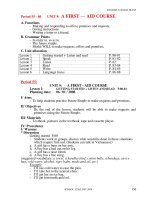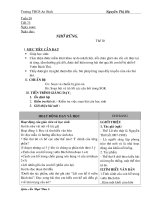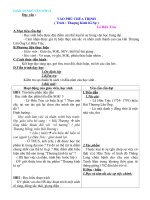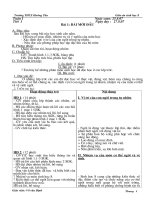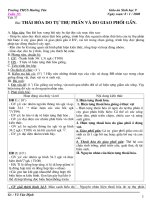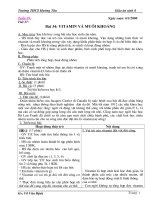Giao An 8 HK I
Bạn đang xem bản rút gọn của tài liệu. Xem và tải ngay bản đầy đủ của tài liệu tại đây (359.57 KB, 92 trang )
Phân phối chơng trình môn tiếng Anh lớp 8
(áp dụng từ năm học 2004-2005)
Cả năm : 3 tiết x 35 tuần = 105 tiết
Học kỳ I : 3 tiết x 18 tuần = 54 tiết
Học kỳ II : 3 tiết x 17 tuần = 51 tiết
Trong đó có 15 tiết dành cho ôn tập, kiểm tra 1 tiết và kiểm tra cuối kỳ
I. Phân phối chơng trình học kỳ I
Số tiết học Bài học Nội dung
1 Ôn tập/Hớng dẫn tiết học
26
Unit 1 ( 5 tiết) -Getting started Listen and read
-Speak and listen
-Read
-Writing
-Language focus
711
Unit 2 ( 5 tiết ) -Getting started Listen and read
Making arangemets -Speak and listen
-Read
-Writing
-Language focus
1217
Unit 3 ( 6 tiết ) -Getting started Listen and read
At home -Speak
-Listen
-Read
-Writing
-Language focus
1819
Kiểm tra viết -Getting started Listen and read
2025
Unit 4 ( 6 tiết) -Speak and listen
-Read
-Writing
-Language focus
-Chữa bàI kiểm tra
2631
Unit 5 ( 6 tiết) -Getting started Listen and read
Study habits -Speak
-Listen
-Read
-Writing
-Language focus
3237
Unit 6 ( 6 tiết) -Getting started Listen and read
The young pioneers Club -Speak
-Listen
-Read
-Writing
1
-Language focus
38→39
KiÓm tra viÕt
40→45
Unit 7 (6 tiÕt) -Getting started Listen and read
My neighborhood -Speak and listen
-Read
-Writing
-Language focus
-Ch÷a bµI kiÓm tra
46→51
Unit 8 ( 6 tiÕt) -Getting started Listen and read
-Speak
-Listen
-Read
-Writing
-Language focus
52→54
¤n tËp vµ kiÓm tra häc kú I
II. Häc kú II
1 ¤n tËp
1→6
Unit 9 ( 5 tiÕt ) -Getting started Listen and read
A fits – Aid Course -Speak and listen
-Read
-Writing
-Language focus
7→11
Unit 10 ( 5 tiÕt ) -Getting started Listen and read
Recycling -Speak and listen
-Read
-Writing
-Language focus
12→17
Unit 11 ( 6 tiÕt ) -Getting started Listen and read
Traveling Around Vietnam -Speak
-Listen
-Read
-Writing
-Language focus
18→19
KiÓm tra viÕt ( 2 tiÕt) ¤n tËp vµ kiÓm tra
20→25
Unit 12 ( 6 tiÕt ) -Getting started Listen and read
Vacation Abroad -Speak and listen
-Read
-Writing
-Language focus
-Ch÷a bµI kiÓm tra
26→30
Unit 13 ( 5 tiÕt ) -Getting started Listen and read
-Speak and listen
-Read
2
-Writing
-Language focus
31→36
Unit 14 ( 6 tiÕt) -Getting started Listen and read
Wonders of the World -Speak
-Listen
-Read
-Writing
-Language focus
37→38
KiÓm tra viÕt ¤n tËp vµ kiÓm tra
39→44
Unit 15 ( 6 tiÕt) -Getting started Listen and read
-Speak and listen
-Read
-Writing
-Language focus
-Ch÷a bµI kiÓm tra
45→49
Unit 16 ( 5 tiÕt ) -Getting started Listen and read
Inventions -Speak and listen
-Read
-Writing
-Language focus
50→51
¤n tËp vµ kiÓm tra häc kú II
3
TuÇn 1
Ngµy so¹n :
Ngµy d¹y :
TiÕt : 1
Review and Introduction
I.Objective
-To help students review the main learnt grammar
-To introduce students English 8 book and way to learn effectively
II.Language content
-The main learnt grammars
III.Teaching aids
-Teacher’s and student’s book
IV.Prosedure
1. Warm up
-Greeting
-Checking the number of students
2. Presentation
Review
The present simple tense
*For subject : I, we, you, they
⊕ S + V + O
- S + do not + V + O
? Do + S + V + O
Yes, S + do
No, S + do not
*For subject : She, he ,it
⊕ S + Vs/ Ves + O
- S + does not + V + O
? Does + V + O
Yes, S + does
No, S + does not
The simple past tense
? What do we use present simple tense for
Ss : Answer
? Do you remember how to put verb in
present simple tense
Ss : answer
T : review the form
Note : these adverbs of time can be used in
the present simple tense : today, this week,
this morning, this afternoon, this evening,
this year…
? What is the concept of the simple past
tense
Ss : Answer
? How many forms of verbs in the simple
past tense
4
⊕ S + V in the past + O
-S + did not + V + O
? Did + S + V + O
Yes, S + did
No, S + did not
Ss : answer
T : review the form
Note : these adverbs of time can be used in
the simple past tense : yesterday, last week,
last year, ago…
3. Practice
T : gives exercise then ask students do exercise
Ss : do exercise
T : Walk around class to check
Exercise 1 : Put the verbs in the bracket in the correct tense
1. Last year we …………(live ) in Nha Trang with our grandparents but now we……..
(live) in Hue with our parents.
2. Do you like swimming, Ba ? I ………(do) when I was a child but not now
3. Last week I …….(send) my friend Daisy a letter but she ……….(not reply). I…….(be
) very sad now.
4. My father………(not like ) drinking beer but yesterday he……….(have) two big
glasses of beer. He…….(be) happy to receive my mother’s news.
5. What…….you………(do) yesterday? I ……(phone) you but you……..(not be) in.
T : call students do exercisse
Ss : do exercise
T : give remark and correct anwer
Answer :
1. lived/ live
2. did
3. sent/did not reply/am
4. does not/ had/was
5. did…do/phoned were not
4. Production
Teacher repeats the present simple tense and the simple past tense
5. Homework
Exercise 1 : Put the verbs in bracket in correct tense
1. I………(think) you ………( not like) chocolate but I was wrong
2. Nam is a careful driver but yesterday he………(drive) carelessly
3. I………(not know) how to dance when I ………..(be) six years old.
……………………………….
Ngµy so¹n :
5
Ngµy d¹y :
TiÕt : 2
Unit 1 : My friends
Lesson 1 : Getting started Listen and read
I.Objective
By the end of the lesson, students will be able to know more about Hoa-Lan-Nien and to
review simple present and simple past
II.Language content
Attributive and predicative adjectives
III.Teaching aids
Text book, cards
IV.Prosedure
1. Warm up
2. Pre-reading
-To seem :
-A next door neighbor : a person who lives
next to your house
-To look like :
3. While-reading
Answers :
a. She is Hoa’s friend
b. She’s twelve years old
c. She lives in Hue
T : show each picture (page 10) then ask
? What are they doing
Ss: answer
? Work in pair about these picture
Ss : work in group
T : Walk around class to check some group
T : Call some pairs to present
T : Correct pronunciation mistake if any
? What do you do in your free time
Ss : answer their own
T : supply new words and their
explaination
Ss : take note
T : lead students remember vocabulary by
rub out and remember method
T : rub out each English word and point to
the Vietnamese translation and ask “
What’s this in English?”
Ss : say the word in English
? Now you work in pair to answer the
following questions
? Is Nien Lan’s friend or Hoa’s friend
? How old is Nien
? Where does Nien live
? Is she a beautiful girl
? Read the dialogue between Hoa, Lan and
Nien on page 10 and check if your answer
are correct or not
Ss : read to check the answer
? Read the dialogue in pair
6
d. Yes, she is
Answer :
a. Nien lives in Hue
b. No, she doesn’t
c. The sentence is “she wasn’t old enough
to be in my class”.
d. At Christmas
4. Post-reading
Answer :
a. Lan is Hoa’s best friend
b.They are in the same class at QT school
c.Last year, Hoa went to school first time
d.Lan showed her arround to introduce her
to new friends
5. Homework
Do exercise 1 in your exercise book
T : call some pairs to read the dialogue
? Look again the dialogue then answer the
questions in exercise 2 on page 11
Ss : work in pair
T : call some pairs to present
T : give remark and correct answer
Ss : take note
? Write a paragraph about Hoa and Lan.
Using some cues and the simple present or
simple past tense to write individually
? you can discuss with your partner to find
the most suitable answer
Cues :
a. Lan / Hoa’s best friend
b. They/ same class / Quang Trung school
c. Last year/ Hoa/ to school first time
d. Lan / show/ arround/ introduce/ to new
friends
T : call some ss to answer
T : correct mistake if any
Ss : take note
……………………………………………
Ngµy so¹n :
7
Ngµy d¹y :
TiÕt : 3
Lesson 2 : Speaking and listen
I.Objective
-to practice describing person in the pictures
-to practice listening comprehensive listen how to introduce and anwer introduction
II.Language content
Adj of person description
Simple tense
III.Teaching aids
Teachers’ and students’ book
Pictures
IV.Prosedure
1.Warm up
-fat -straight
-slim -long
-tall -short
-overweight -black/dark
-slender -blond/fair/grey/brown
2.Presentation
Form:
S + have/has + adjectives + hair
S + be + adjectives
3 . Practice:
a. He/tall/thin →He is tall and thin
b. She/short/slim →She is short and slim
c. He/short/fat →He is short and fat
d. She/long/black →She has long black
hair
e. She/curly/blond →She has curly blond
hair
f. She/Straight/brown →She has straight
brown hair
Practice speaking :
? please think of the adjectives used to
describe body build and hair
Ss : work in group to find out the adjectives
T : call some ss to present
Ss : say the adjectives they know
T : show students a picture of Mary and ask
them to describe her hair, her body build
Ex : She has long blond hair
She is short and thin
T : Introduce the form
T : prepare 6 cards so that students can drill
easily
Ss : work in group
T : call some ss to anwer
?Look at six people on page 11-12 then
describe these people
Ss : prepare information
T : call on a student to describe one person,
the others have to guess who he/she is
Example
S1 : This person is short and thin. She has
long blond hair.
8
4. Pre-listening
5. While-listening
6. Post-listening
7 . Homework
Do exercise in exercise book
S2 : Is this Mary
Yes
T : do the same with other posters
T : may ask students to describe a famous
person ot one of their classmates and their
friends have to guess.
? Please do exercise “listen a, b, c,d on
page 12-13”
T : give the expressions and ask ss if they
understand their meaning
Ss : work to guess and to complete four dia.
T : let students listen to the tape twice
Ss : listen
? Work in pair to complete the dia. And
compare with their prediction
T : call some pairs to practice these dia.
Ss : practice
T : correct mistake and pronunciation if
any
TuÇn 2
9
Ngµy so¹n :
Ngµy d¹y :
TiÕt : 4
Lesson 3 : Read
I.Ojective
-to help student reading comprehensive : read a passage and know more about Ba’s
friends
II.Language content
The present simple
Words of character, habit
III.Teaching aids
Teacher’s and student’s book
Picture
IV.Procedure
1. Warm-up
2. Pre-reading
A character : mét nh©n vËt
An orphanage : a place where children
without parents live
Reserved (adj ) : dÌ dÆt
Sociable (adj) : hoµ ®ång
To tell jokes : kÓ chuyÖn vui
Sense of humor : cã khíu hµI híc
T/F statement prediction
a. Ba only has three friends-
Bao,Song,Khai
b. Ba and his friends have the same
? Look at 4 pictures in page 10 and talk
about the activities you want to do after
school
Ss : discuss
T : give some sugesstions
?What are these students doing
Ss : play soccer/play chess/read books/ play
volley ball
?What time of the day do you think it is
Ss: in the morning/evening/after school
?Do you like soccer/reading book…
T and ss work together
T : supply new words by translation or
explaination
Ss : take note and try to remember the new
words
T : Write the word on board, put the word
in each circle
T : have students repeat the words in
chorus then rub out word by word but leave
the circles
Ss : repeat the words
T : Point to each circle and ask students to
repeat chorally the English words
?Who can go to the board and write the
words again in the correct circle
T : these statements are about Ba and his
friends, read them and guess which
statements are true, which are false.
10
characters
c. Bao-Song-Khai are quite reserved in
public
d. They all enjoy school and study hard
3. While-reading
a. F
b. F
c. F
d. T
Exercise 1
Answer
1.A
2.C
3.B
4.D
Exercise 2
a. He feels lucky having a lot of friends
b. Bao is the most sociable
c. Khai likes reading
d. His jokes sometimes annoy his friends
e. Bao spends his free time doing
volunteer work at a local orphanage
f. Students’ answer
4. Post-reading
5. Homework
Ss : work in pairs
T : receive feedback
? Open your books and read the text on
page 13
Ss : read
? Check your prediction
?Correct false statements
Ss: do the correction
? Read the pasage again then do exercise 1
on page 14
T: you can work in pair to find the most
suitable answers
T : call some ss to answer
T : correct mistake if any
? work in pair to ask and answer questions
in exercise number 2
Ss : work
T : walk around to held
T : call some pairs to present
T : correct pronunciation mistake if any
T : divide class in to 6 groups and ask ss in
each group talk to one another about their
friends, using the adjectives they have
learnt to describe
Ss : work in group
T : Walk around class to help
? Write a paragraph about one close friend
Ngµy so¹n :
11
Ngµy d¹y :
TiÕt : 5
Lesson 4 : Write
I.Objective
By the end of the lesson, students will be able to write a paragraph about their close
friends
II.Language content
The present simple
Adjectives of character
III.Teaching aids
Teacher’s and students’ book
IV.Prosedure
1.Warm-up
Answer :
a. Four people
b.
-The woman is wearing a red shirt and a
green skirt
-The man who is standing beside the car is
wearing brown trousers and a yellow shirt.
-The man who is standing on the pavement
is wearing a pink shirt and blue trouswes.
-The boy is wearing blue short and a white
shirt
2. Pre-writing
Answer :
a. Le Van Tam
b. He is 14 years old
c. He is tall and thin. He has short black
hair
d. He is sociable, humorous and helpful.
e. He lives at 26 Tran Phu street, HN
f. He lives with his mother, father and an
elder brother.
g. Ba and Bao
3. While-reading
?Look at picture on page 17 quickly in 20
second then close your books
T : Now you are going to work in 4 group
to find information to answer the following
two questions :
1. How many people are there in the
picture?
2. What is each person wearing?
Ss : work in group. The group which
answer correctly the fastest wins the game
? Open your book page 15 then read the
information about Tam and answer some
questions
1. What is his name?
2. How old is he?
3. What does he look like?
4. What is he like?
5. Where does he live?
6. Whom does he live with?
7. Who is he friend?
Ss : read information then work in pair to
answer the questions
T : call ss answer
T : correct mistake if any
T : Now you have to write a paragraph
about Tam, using the information you have
just got. Please work independently
12
4. Post-writing
5. Home work
Ss : write
T : walk around to help
? Compare your results with the paragraph
in your book page 15.
T : you write the similar paragraph about
one of your friend
Ss : can check the result together
?Each of you have to write a similar
paragraph about yourself
Ss : work independently
T : move around class to help students then
ask students to speak in front of the class
about himself
Write another paragraph about one of your
family member
13
Ngµy so¹n :
Ngµy d¹y :
TiÕt : 6
Lesson 5 : Language focus
I.Objective
-To practice more in simple present tense and the stucture (not) + adjectice enough + to-
infinitive
-By the end of the lesson, students will be able to use simple present tense to talk about
feneral truths and write some sentences using the structure “not + adjective enough + to-
infinitive”
II.Language content
Simple present tense, not + adjective enough + to-infinitive
III.Teaching aids
Teacher’s and student’s book
IV.Prosedure
1. Warm-up
Categories
Example
T writes a b c d
Student awful big clever dirty
T writes g h I j
Student ……………………………….
2. Language focus
Revision of simple present tense
*S +V/Vs (es) + O
*S + do not/does not + V + O
*Do/Does + S + V + O
Yes, S + do/does
No, S + do/does + not
Answer :
Tuan : rises/sets/goes/is/is
Ba : moves/is/
Revision of structure : S + to be +(not) +
adjective enough + to-infinitive
T asks student to find out the adjectives
beginning with the letters that the teacher
give
T : divide the class into two groups
T : give four letters at the same time
Ss : discuss in group to find out the
adjectives
T : give one mark fot the team which
finishes first
? We use the simple present tense for what
purpose
Ss : answer : it is used to express an action
which is always true
T : give five verbs : be-move-set-rise-go
and ask students to complete the dialogue
between Ba and Tuan, his young cousin.
Let work in pair
Ss : complete the dia. In pair
T : call some pairs to practice before class
T : correct mistake if any
T : set the scene to review the structure:
teacher is to ask students to hang the
picture on board “ How do I say and how
do you answer?” Complete the exchange
14
Word-cue drill
a. Read English books/good (v)
-Can you read English books?
-Yes, my English is good enough to read
English books
b. Drive a car/old (x)
c. Carry this bag/strong (v)
d. Solve this problem/clever (x)
3. Further practice
Answer :
a. Not big enough
b. Not old enough
c. Strong enough
d. Good enough
4. Summary
5. Homework
Can you (1) this (2) over there?
No I (3)not (4)(5)to(6) the(7) over there.
Answer :
T : Can you hang this picture over there?
S : No, I am not tall enough to hang the
picture over there.
T asks ss to work in pair, one asks and the
other answer
Ss : work in pair
T : call some pairs to present
? Do exercise 4 on page 17 in pairs
Ss : do exercise
T : call students to practice in pair
T : correct mistake if any
T repeats simple present tense and the
structure : (not) + adjectives enough + to-
infinitive
? Do exercise 1 in page 16 and write five
sentences about themselves using the
structure : (not) + adjectives enough + to-
infinitive
15
TuÇn 3
Ngµy so¹n :
Ngµy d¹y :
TiÕt : 7
Unit 2 : Making arrangements
Lesson 1 : Getting started Listen and read
I.Ojective
Students will be able to use the telephone to make and confirm arrangements
II.Language content
“Going to” talks about intentions and activities in the future
Adverbs of place
III.Teaching aids
Teacher’s and student’s book
IV.Prosedure
1. Warm-up
Definition
1. to send fax
2. to find someone’s telephone number
3. to write addresses and telephone
numbers
4. to make a phone call in a street
telephone box
5. to leave and take messages
6. to make phone call anywhere you like
Answer
a-5 d-2
b-6 e-4
c-1 f-3
2. Pre-reading
T asks students to match each object
(pictures on page 18) with its name
T give the definitions of these objects on a
poster and ask students to match the object
with its definition
Ss : observe the objects the match
T : Hoa and Nga are talking on the phone.
They are talking about going to see a
movie
Please guess:
?Who make the call
?Who introduced herself
?Who invited the other to the movies
?Who arranged a meeting place
?Who arranged the time
?Who agreed to the time
Ss : answer as their guessings
16
3. While-reading
Answer:
a. Nga make the call
b. Nga introduced herself
c. Nga invited Hoa to the movies
d. Nga arranged a meeting place
e. Hoa arranged the time
f. Nga agreed to the time
Comprehension questions
a.What’s Hoa’s telephone number?
b.Which movie are they going to see?
Where?
c. How is Hoa going to see the movies?
d. Where are they going to meet? What
time?
Answer
a. Her telephone number is 3847329
b. They are going to see the movie Dream
City at Sao Mai Movie Theater
c. Hoa is going by bike
d. They are going to meet outside the
theater at 6.30
4. Post-reading
5. Homework
?Read the conversation between Nga and
Hoa on page 19 and give them feedback
Ss : work individually
T : call students answer the questions
? Work in pair to ask and answer
comprehension questions
Ss : work in pair
T : call some pairs to ask and answer
T : correct pronunciation mistake if any
T : now you play the roles of two students
who are talking on the phone making
arrangements.
Ss : work in pairs
T: move around the class and help the
students
T asks students to write a similar dialogue
on their notebooks.
17
Ngµy so¹n :
Ngµy d¹y :
TiÕt : 8
Lesson 2 : Speak
I.Ojective
Students will be able to talk on the telephone about intentions with Going to
II.Language content
Structure : S + to be+going to + V
III.Teaching aids
Teacher’s and student’s book
IV.Prosedure
1. Warm-up
2. Presentation
Answer :
1-b
2-f
3-j
4-a
5-I
6-c
7-e
8-k
9-g
10-h
11-d
S + to be + going to + infinitive
3. Practice
Model sentences :
Are you going to see a movie?
Yes, I am/ No,I’m not
a. see a movie (v)
b. play sport (x)
c. meet friends (v)
d. help your mother (v)
e. do your homework (x)
Chatting
?Do you have a telephone at home
?How often do you make a phone call
?What would you say when you pick up the
phone to answer it
?What would you say if you are the caller
? Do exercise 1 on page 20. Work in pair to
put the sentences in the correct order to
make a complete conversation
Ss : discuss in pair
T : call some pairs to present the dia.
T : correct mistake if any
T : introduce the form of verb used to talk
about intention
Ss : take note
T : lead students do exercise
T : call some pair to make examble
? Work in pair asking and answering
Ss : work
18
f. watch TV (x)
4. Production
Complete the dia. Between Ba and Bao
1. May I speak to Ba, please? This is Bao
2. I’m fine thanks. And you?
3. Can you play chess tonight?
4. What about tomorrow afternoon?
5. I’ll meet you at the Central Chess club
6. Is 2.00 o’clock OK
5. Homework
T : Ba and Bao are making arrangements to
play chess. Please complete the dia.
Ss : work in pair
T : call students play the roles of Ba and
Bao to practice the dia
T : correct pronunciation mistake if any
T : Now you make the similar
arrangements and practice talking with a
partner
?Write five things that you intend to do
next week
19
Ngµy so¹n :
Ngµy d¹y :
TiÕt : 9
Lesson 3 : Read
I.Ojective
By the end of the lesson, students will be able to know more about Alexander Graham
Bell
II.Language content
Words of telephone
III.Teaching aids
Teacher’s and student’s book, pictures of Bell
IV.Prosedure
1. Warm-up
Brainstorming
What is the telephone used for?
-to chat with friend
-to communicate
-to do bussiness
-to have a message
-to call someone
-to make arrangement
-to talk to a person who lives far from
-to get information at the airport or railway
station quickly
2. Pre-reading
Emigrate (v): go to another country to live
Transmit (v) : chuyÓn
Conduct (v) : synonym of carry out
Demonstrate (v): biÓu t×nh,
Device(n) : thiÕt bÞ
Deaf-mute : a person who is unable to hear
and speak
T/F statement prediction
a. Alexander G. Bell was born in the USA
T lets students answer the question freely
Ss : answer according to their
understanding
T : introduce new words
Ss : take note
T: have students repeat the words in chorus
then rub out word by word but leave the
circles. T lets ss repeat words before and
after rubbing each word
T : go on until students can remember the
words
T : can call ss to write the words again in
thecorrect circles
T : hang the poster of T/F statements on the
board and ask ss to work in pair and guess
20
b. He worked with deaf-mute patients in a
hospital in Boston
c. Thomas Watson was Bell’s assistant
d. Thomas Watson introduced the
tetephone in 1877
e. Bell experimented with ways of
transmitting speech between deaf-mutes
over a long distance
f. Bell demonstrated his invention at a lot
of exhibitions
3. While-reading
Guess Answer Correction
a F In Scotland
b F Boston Univer
c T
d F In 1876
e F Tran. speech
f T
Ordering
Alexander Graham Bell
1. was born in Scotland
2. went to live in Canada
3. went to live in the United States
4. worked with people who could neither
speak nor hear
5. worked with Thomas Watson
6. successfully demonstrated his invention
7. invented the telephone
4. Post-reading
Suggestion :
A.G Bell was born on Match 3
rd
,1847 in
Scotland. He went to live in Canada and
then to the U.S.A in 1870s. He worked with
deaf mutes at Boston University and did
experiments with ways of transmitting
speech over a long distance. In 1876, he
and his assistant-Thomas Watson
introduced the telephone successfully and
in 1877 the first telephone was in
commercial use.
5. Homework
which statements are true and which are
false
Ss : give feedback
? Read the text on page 21-22 and check
your prediction
Ss : read and check
? Correct the false statements
? Read the text again and put the events of
Bell’s life in order
Ss : work individually
? Compare result with your partner
? Write a paragraph about Bell’s life, using
the information from the text
T : walk around to help
T : call some ss read their writing
? Rewrite the paragraph on your notebooks
TuÇn 4
21
Ngµy so¹n :
Ngµy d¹y :
TiÕt : 10
Lesson 4 : Writing
I.Ojective
By the end of the lesson, students are able to write a telephone message
II.Language content
Telephone message
III.Teaching aids
Teacher’s and students’s book
IV.Prosedure
1. Warm-up
1.mcuestor = customer
2.ayddmi = midday
3.essgmea = message
4.nifurretu = furniture
5.rvseice = service
2. Pre-writing
Chatting :
Pre-teach vocabulary
A customer (n) : a person who come to buy
something at a shop
A delivery (n) : ph©n phèi
Stationery (n) ®å v¨n phßng
To pick up someone : ®ãn ai
3. While-writing
Reading and gap filling
Phoned/May 12/speak/took/
name/delivery/at
T : write the words whose letters are in a
random order on the board
T : divide the class into 2 teams. Students
from 2 teams go to the board and write the
correct words. The team which writes more
correct words first wins the game
T and the whole class talk about taking a
telephone message
? Have you ever taken a telephone message
Ss : answer : yes/no
? When you take a message, what should
be mentioned in the message
Ss : Date, time, who sent, to whom, content
? Open your book page 23 and read the
first message then filling missing
information
Ss : work independently
T : ask ss to compare results with partner
T : call some ss to read result
T : give remark and correct mistake if any
T : ask ss to read the passage 2 on page 23
22
Write the telephone message
Answer :
Thanh Cong delivery Service
Date : June 16
Time : After midday
For : Mrs Van
Message : Mr . Nam called about his
stationery order. He wanted you to call him
ar 8634082
Taken by : Mr Toan
4. Post-writing
Write more message
Date :
Time :
For : Nancy
Message : Tom called about playing tennis
this afternoon. He will come over to pick
you up at 1.30
Taken by : Lisa
5. Homework
to get information and write the message
Ss : work individually then share with a
partner
T : call two ss to write the message on
board
T : call other to give remark and correct
mistake if any
T : Tom phoned Nancy but she was out.
Lisa, Nancy’s sister took a message for
Nancy. Help Lisa to write a message
?Read the dia. Between Lisa and Tom to
write a message
? You can work in pair
Ss : discuss to find out the main
information
T : receive feed back
?Write the message on their notebooks
Ngµy so¹n :
23
Ngµy d¹y :
TiÕt : 11
Lesson 5 : Language forcus
I.Objective
By the end of the lesson, students will be able to complete telephone message and further
practice in structure of intention and adverbs of place
II. Language content
Structure if intention and adverbs of place
III.Teaching aids
Teacher’s and student’s book
IV. Prosedure
1. Warm-up
Telephone transmitting
2.Pre-listening
3. While-listening
Answer:
Kingston Junior High School
Date :
Time :
For : the principal
Message : Mr Mary Nguyen wanted to see
you at 9.45 in the morning
Telephone number : 64683720942
4. Language forcus
S + to be + going+ to-infinitive
a.They are going to go fishing
T : divide students into two teams
T : Choose 6 volunteers stand in two lines.
The teacher shows the first student (in each
line ) a telephone number. The volunteers
whispers the telephone number to the next
person in his/her line. The second student
whisper to the third…intil the last one. The
last student shouts out the number, if it is
the same as the number teacher shows, that
team wins the match
?Look at the form of the telephone
message on page 21 and fill the missing
information
T : a woman phoned the principal of
Kingston junior high school, but he was out
?Work in pair to guess the message
Ss : give feedback
T : supply again the form of verbs talking
about intention
?Do exercise 1 on page 25
?Exchange result with your friends
24
b. She’s going to read a new novel
c. She’s going to do homework in Math
d.He’s going to see an interesting action
movie on TV tonight
e. She’s going to her her friend’s birthday
5. Practice
Answer:
a. Where is Tuan? I think he is upstairs
b. No, he isn’t here
c. He isn’t downstairs and he isn’t upstairs
d. Perhaps he’s outside
e. No, he isn’t there
f. I’m not outside. I’m inside, Ba
6. Homework
T : call some ss write result on the board
?Copy the questionnaire in your book then
discuss about the intention
T : walk around to check ss’s working
?Do exercise 3d on page 26
T : Ba is playing hide and seek with his
cousin, Mr Tuan. Use the adverbs of place
to complete the speech bubbles.
?Work in pairs then compare with another
pair
T : call ss to read out the speech bubbles
T : correct mistake if any
? Write 6 sentences about your house,
using adverbs of place
Ngµy so¹n :
Ngµy d¹y :
25
